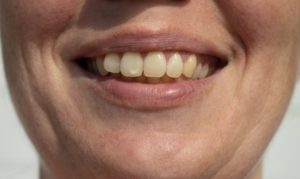
Although it might seem like a cause for concern, and though they’re certainly undesirable, having white spots on your teeth is no reason to panic or sound the alarm! In most cases, they’re rarely considered an issue from a medical point of view—and it’s also often an issue that can be resolved with the help of your dentist. Keep reading to learn more!
Possible Explanations for White Spots on Teeth
Here are a few possible causes for white spots appearing on your teeth:
- Dental fluorosis – Although fluoride greatly benefits your pearly whites, too much of a good thing can still cause problems! This condition tends to develop before the teeth break through the gums, especially in children that consume a lot of fluoride.
- Enamel hypoplasia – This condition occurs when enamel doesn’t form properly. Like fluorosis, hypoplasia only occurs when a person’s teeth are still developing. However, it can also increase the risk of tooth decay, making it potentially problematic.
- Poor dental hygiene – Neglecting to take care of your smile can easily lead to tooth discoloration of various types, including white spots.
- Unhealthy diet – A diet that’s low in calcium can result in white spots on your teeth. Certain acidic or sugary foods can also lead to enamel decalcification.
- Certain medications – Certain medicines such as amoxicillin or other antibiotics can affect your enamel, leaving your teeth more vulnerable to bacteria that results in discoloration.
How Your Dentist Can Help
White spots on your teeth can quickly become a source of frustration, especially when the cause isn’t clear! However, it’s an issue that can easily be addressed with the help of your dentist. In many cases, teeth whitening is a viable solution; a professional-grade bleaching solution is applied to the teeth, which works to break up visible surface staining on the enamel. There are a variety of other teeth whitening products that can be bought at the store or online, but these aren’t as effective as seeing your dentist.
Other potential solutions include veneers; your dentist can bond thin sheets of porcelain to the outer surfaces of the affected teeth, immediately improving their appearance and hiding any discoloration. In other cases, a topical fluoride (to combat enamel hypoplasia), composite resin bonding, or enamel microabrasion is sometimes utilized.
Since your smile often is the first thing that people notice about you, you should ensure that it’s free of any noticeable issues like white spots; if you’re able to see them in the bathroom mirror, that means that other people can too!
About the Practice
South Ridge Dental is thrilled to serve the dental needs of the Lincoln area under the leadership of Dr. Ryan Shaffer and Dr. Steven Shaffer. Their practice is pleased to offer a wide range of preventive, cosmetic, and restorative treatment options. If you have any questions about the article or you’ve recently discovered white spots on your teeth, don’t hesitate to contact the practice online or by phone for assistance: (402) 423-1616.
